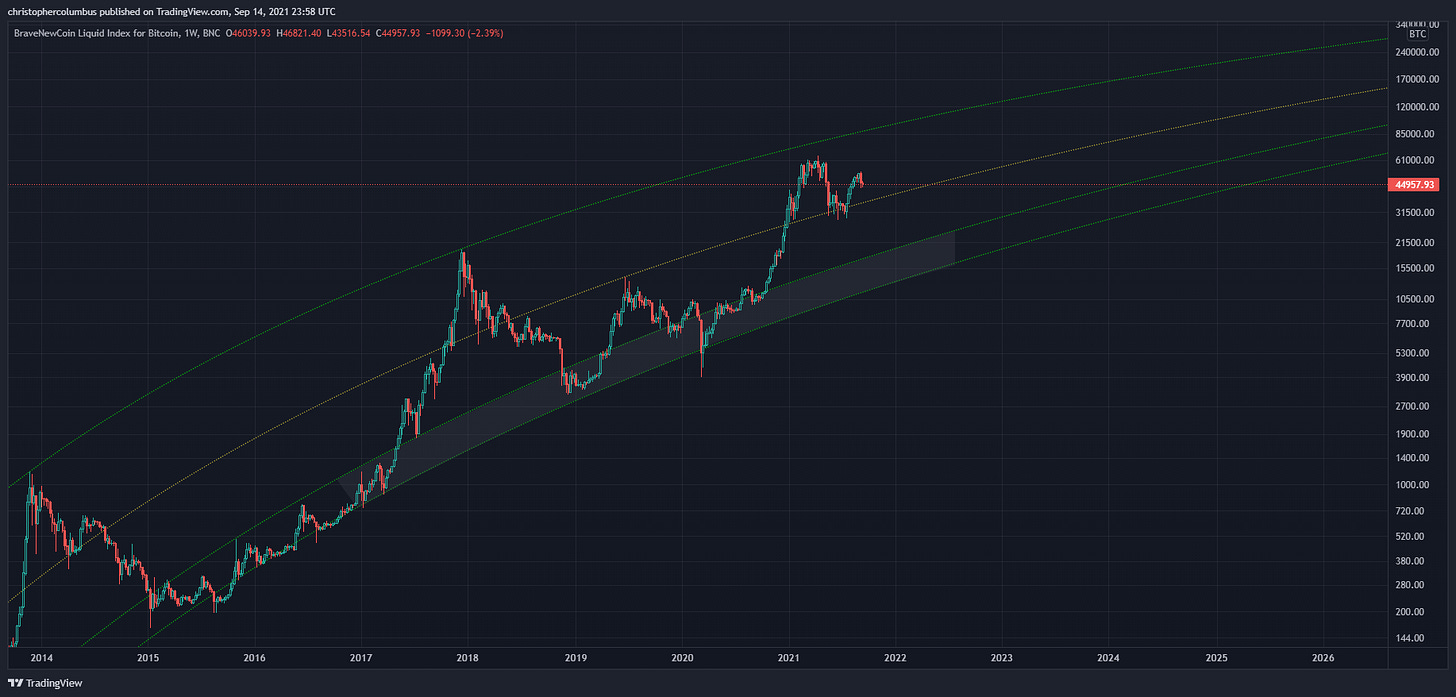Dear Readers,
While I was vacillating between topics, a timely question, as posted on Twitter, resolved my dithering for me. I often get asked whether we are now in a bear market or not, or on the cusp of such. It’s a question that I’m reluctant to give a direct response to as I find the language of that query itself questionable. What I mean here is that I think the phrase ‘bear market’ is too ‘loaded’, and accordingly can perhaps distort our view of the market. This article will be the unpacking of that language in order to re-frame what may be developing in the market in a more sober and less partisan manner.
To begin with, the trader/ investor’s competitive advantage lies in a distancing from the orthodox and often militant language of bear/ bull. Of course the more volatile and heated markets [such as Crypto] largely consist in the mass of market participants either divided into ‘bulls’ and ‘bears’, or flip-flopping between such as they seek to take advantage of price. But the savvier trader/ investor may hold various positions, on various time-frames, in the balance similtaneously. In this sense, they will be a contrarian in principle insofar as they maintain a largesse of mind that refrains from identifying with the monikers of either bear or bull [always a reduction]. Nor does this necessarily entail a complete lack of ‘commitment’ toward the object of investment such as the purest of traders might exhibit, for, as mentioned, all positions are to be held in the balance. This is to say that there is no one single mode or mindset that motivates the contrarian here. The fundamental principle of the contrarian is exactly this - a pragmatic fluidity and flexibility in contrast to a rigid, doctrinaire, programmatic approach. Just as the market is a performance of price development, the trader/ investor has this performative aspect first and foremost in mind [a mindset in motion and not static]. What matters primarily are results not truths; what is and not what ought to be. I say ‘primarily’ because the investor, always interested in finding a long-term trend at work, will keep an eye on the fundamentals as to why a perceived trend should be so. But these fundamentals will in no way over-ride, or determine, all other considerations. Rather, they’ll be held in the balance with all else, with the pivot point of that balance being the most pragmatic of all principles, that of uncertainty. Though one could have confidence in a fundamental analysis, or in a market trend, it would always be hedged against. In this regard, the uncertainty principle is also the reality principle - anything could happen. With these thoughts in mind, the monikers of bear and bull, and the absolute identification with such [in a twist on identity politics] starts to look like more of a hindrance than a help. Sure, be bullish, but make sure to be bullish at the right time, in the right circumstances, and in the right weighting. Here there are many moving parts within which the language needs to be contextualized. Which brings us back to the question - could we be in a bear market?
Just as the language of bear and bull, as applied to market participants, is problematic, so too is the language as applied to the market itself. In this sense, they are in reality two sides of the same coin, for those participating in markets will of necessity interpret them a certain way. One would hope to have a semblance of objectivity in reading the market, and yet if locked into a dichotomous bull/ bear narrative of that market, there is the risk of simply projecting your own pre-occupation or mindset. In this scenario, there is no room for disinterestedness/ objectivity. Here the disappointed or disillusioned ‘bull’ may suddenly flip to seeing a bear market, where that submerged and lurking fear, long repressed by a laser-like/ singular focus on bullish fundamentals, will rise to the surface with a vengeance. And little wonder, for in reading markets as simply comprised of ‘bulls’ and ‘bears’ [which is continually promoted and marketed], they are seen in purely antithetical, and dare I say it, bipolar terms. A ‘bi-polar’ view of markets will translate then into bi-polar market behavior. Lacking that critical distancing, by which hedging becomes possible, those caught up in this most simplistic of narratives are at risk of bouncing about like Tweedle-dee and Tweedle-dum depending on the flavor or sentiment of the day - buy, sell, buy, sell, buy, sell. Having put in a groundwork here, one that distances itself from the dichotomous, mutually exclusive, and loaded language of ‘bear or bull market?’ I’ll look now to answer this question more pragmatically, and more comprehensively.
First of [and let’s take Bitcoin as our obvious subject here], we can be confident that BTC is in a long-term bull market, in what is often referred to as a secular bull. To the unjaundiced eye, the first long-term chart shows a clear progress. The so-called problem of whether we are in a ‘bear or bull market’ only arises when we zoom in on the more medium-term as seen in the second chart [the short-term is largely irrelevant to our purposes as it consists mostly of random unpredictable volatility].
With price relatively high and in the top half of this [LGC] channel, the market participant is left wondering whether price will be pushed to new heights here or whether prices will instead correct. As those following me know only too well, on the basis of [fallible] TA, I’m of the persuasion that they will correct. Of course the point of this present article is not to discuss that TA, but to answer the question as to whether BTC would be in a ‘bear market’ IF price did happen to continue correcting. And my answer to that is no, it would just be in a correction. Some might think this is a matter of semantics, but I think a careful use of language is important here [as discussed above]. A ‘bear market’ can evoke the idea of a multi-year collapse in prices that can plummet over 80%. As you can see, that language is loaded, and accordingly that idea can become something to be strenuously resisted in order to avoid throwing into doubt the assurances of the bull narrative [‘cognitive dissonance’ being avoided at all costs]. Of course, if the market were to head lower, the facts would assert themselves. And then an unfortunate and reactionary mindset might also assert itself - a ‘flipping’ into the bear mode. If however, the participant here just viewed the current development as Bitcoin normal - a healthy correction of a speculative parabolic spike up - then a further correction would just be seen as that; a correction as opposed to the horror of a prolonged ‘bear market’. It was with this developing nature of the market in mind, where a more mature and liquid market would lead to shorter boom and bust speculative episodes, that a previous article was written. The basic idea being that a more liquid and mature market, on its path toward price discovery, would make redundant the older [and orthodox] notions of grand multi-year bull and bear markets. If the market has moved on, why not the ‘narrative’.
And finally to the medium term TA, which maps out just a correction as opposed to a ‘bear market’. Keep in mind it involves a higher degree of speculation than the long term model of the LGC itself. This is because it is more ambitious and attempts to more specifically describe the way in which price will develop on a shorter more medium time-frame. Due to this it should obviously be taken with a grain of salt. One might disagree with it, and that would be fine. One could consider it a game of sorts and then approach it with some sportsmanship. TA is not for those that find this difficult, which is also fine. For some that see BTC as the best thing since sliced bread, and the mapping out of potentially lower prices as akin to looking a gift horse in the mouth, then TA, of the realistic variety, is not for them. Best to consider the longer term models and the fundamentals. Of course, there then remains that most vocal minority who see any ‘bear’ chart as a kind of treacherous act. From a displaced patriotic fervor, they will attack anything contrary to their cherished beliefs [contrarianism is quite literally unthinkable for them]. TA for them is equated with propaganda, for good or bad. Little can be done with this kind of decadence of mind. Enter the troll. But I digress, back to the TA and the chart, for those of us with the inclination to play such games.
Even if, hypothetically speaking [which should go without saying], price were to continue correcting to say 50 or 61% of the previous parabolic rise, I would not consider this a bear market but a correction. This is because the nature of the market has changed, where we are now looking at much shorter ‘booms and busts’. Just as previous corrections culminated in a very quick and massive move to the upside, so too I think you’ll see more of the same going forward. I’d say that on the lowest of corrected prices [should they eventuate] you’ll see an army of tweedle-dums [once tweedle-dees] calling for ever lower prices just at the time they should be buying. As for this particular chart, it is a general one. Charts with more detail, and on various time frames, can be found on my Twitter page [@davthewave].
To sum up, it’s been my intention here to answer the question as to whether we could be going into a ‘bear market’. In doing so, I’ve looked to ‘de-escalate’ a language that tends to be loaded with a lot of baggage. In unpacking that baggage, and looking at this once again from a more objective and pragmatic viewpoint, beyond that of ‘bull and bear’, it’s been my aim to show that lower prices need not be thought either unthinkable or undesireable. This is because should those lower prices eventuate, they are likely to be as temporary and unsustainable [given the secular bull market] as those highest prices were at the top. What matters in the end is that corrections in an ongoing bull market are not only healthy but crucial for the the eventual stabilization and sustainability of higher prices in the longer-term. As we all know, bull markets climb a wall of worry, where the ‘bear’s bark turns out to be far worse than its bite. No barking here.
For more on investing and trading the alt coins, feel free to enquire via a DM to my Twitter account - @davthewave
Until next time,
Stay [relatively] safe out there,
Dave the Wave.







